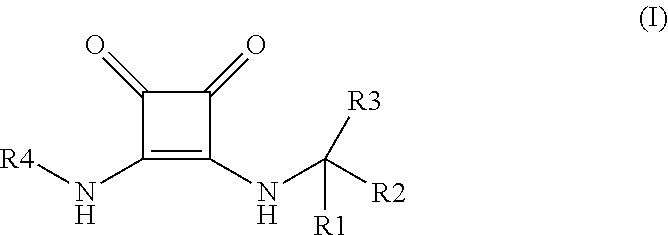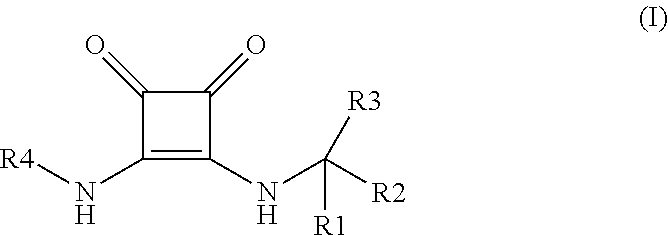Novel disubstituted 3,4-diamino-3-cyclobutene-1,2-dione compounds for use in the treatment of chemokine-mediated diseases
a technology of chemokine-mediated diseases and disubstituted compounds, which is applied in the field of new disubstituted 3, 4diamino3cyclobutene1, 2dione compounds, can solve the problems of insufficient promise of effective new therapies for treating chemokine-mediated diseases using chemokine receptor antagonists, insufficient need, and insufficient clinical studies
- Summary
- Abstract
- Description
- Claims
- Application Information
AI Technical Summary
Benefits of technology
Problems solved by technology
Method used
Image
Examples
example 1
Preparation of 2-hydroxy-N,N-dimethyl-3-(2-{[(5-methylfuran-2-yl)-(tetrahydropyran-4-yl)methyl]amino}-3,4-dioxocyclobut-1-enylamino)benzamide
[0147]
Step 1
(5-Methylfuran-2-yl)-(tetrahydropyran-4-yl)methanol
[0148]12.0 ml (30 mmol, 1.5 eq) of a 2.5 M solution of n-butyllithium in hexane were added dropwise to a solution of 2.46 g (30 mmol, 1.5 eq) of 2-methylfuran in 50 ml of tetrahydrofuran cooled to −70° C. The reaction medium was stirred and allowed to return to ambient temperature for 2 hours. The reaction medium was cooled to −70° C. and then 2.28 g (20 mmol, 1 eq) of tetrahydro-2H-pyran-4-carbaldehyde were added. The reaction medium was stirred at ambient temperature for 2 hours. The reaction medium was treated with a saturated ammonium chloride solution and extracted with ethyl acetate. The organic phases were combined, washed with a saturated sodium chloride solution and evaporated. 4.43 g of (5-methylfuran-2-yl)-(tetrahydropyran-4-yl)methanol were obtained. Yield=100%.
Step 2
4-[...
example 2
Preparation of 2-hydroxy-N,N-dimethyl-3-(2-{[(5-methylfuran-2-yl)-(tetrahydrothiopyran-4-yl)methyl]amino}-3,4-dioxocyclobut-1-enylamino)benzamide
[0156]
Step 1
[0157]In a manner analogous to EXAMPLE 1 (Method A, step 1), (5-methylfuran-2-yl)-(tetrahydrothiopyran-4-yl)methanol was prepared. Yield=86%.
Step 2
[0158]In a manner analogous to EXAMPLE 1 (Method A, step 2), 2-[azido(tetrahydrothiopyran-4-yl)methyl]-5-methylfuran was prepared. Yield=40%.
Step 3
[0159]C-(5-Methylfuran-2-yl)-C-(tetrahydrothiopyran-4-yl)methylamine
[0160]304 mg (8 mmol, 2 eq) of lithium aluminum hydride were added to a solution of 968 mg (4 mmol, 1 eq) of 2-[azido(tetrahydrothiopyran-4-yl)methyl]-5-methylfuran in 10 ml of tetrahydrofuran cooled to −10° C. The reaction medium was stirred at ambient temperature for 2 hours. The reaction medium was cooled to 0° C. and water with a solution of sodium hydroxide at 2 N and diethyl ether were added (precipitation of the aluminum and lithium salts). The reaction medium was fi...
example 3
Preparation of tert-butyl 4-[[2-(3-dimethylcarbamoyl-2-hydroxyphenylamino)-3,4-dioxocyclobut-1-enylamino]-(5-methylfuran-2-yl)methyl]piperidine-1-carboxylate
[0163]
Steps 1 to 7
[0164]In a manner analogous to EXAMPLE 1 (Method A, steps 1 to 7), and using tert-butyl 4-formylpiperidene-1-carboxylate, tert-butyl 4-[[2-(3-dimethylcarbamoyl-2-hydroxyphenylamino)-3,4-dioxocyclobutenylamino]-(5-methylfuran-2-yl)methyl]piperidine-1-carboxylate was prepared. HPLC 99.42%, ES+ [553].
[0165]1H NMR (DMSO-d6, 400 MHz): 1.00-1.25 (m, 2H); 1.38 (s, 9H); 1.45-1.50 (m, 1H); 1.65-1.75 (m, 1H); 1.90-2.10 (m, 1H); 2.28 (s, 3H); 2.60-2.85 (bs, 2H); 2.94 (s, 6H); 0.3.90-4.10 (m, 2H); 5.10 (t, 1H); 6.06 (s, 1H); 6.27 (s, 1H); 6.87-6.89 (m, 2H); 7.80 (d, 1H); 8.70 (d, 1H); 9.37 (s, 1H); 10.00 (s, 1H).
PUM
| Property | Measurement | Unit |
|---|---|---|
| Composition | aaaaa | aaaaa |
Abstract
Description
Claims
Application Information
 Login to View More
Login to View More - R&D
- Intellectual Property
- Life Sciences
- Materials
- Tech Scout
- Unparalleled Data Quality
- Higher Quality Content
- 60% Fewer Hallucinations
Browse by: Latest US Patents, China's latest patents, Technical Efficacy Thesaurus, Application Domain, Technology Topic, Popular Technical Reports.
© 2025 PatSnap. All rights reserved.Legal|Privacy policy|Modern Slavery Act Transparency Statement|Sitemap|About US| Contact US: help@patsnap.com



